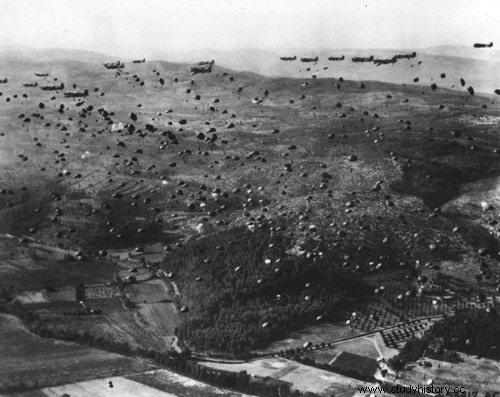
Urquhart was therefore forced to choose landing zones quite far from the city. He could not retain the open ground which is about 6 kilometers north of Arnhem because, while the area was very dry and hidden from the city by woods, it was cut too many dunes and bushes to allow landing. of a large number of gliders. He also had to reject the very open area south of the river, not only because of the expected flak, but also because the terrain was very heavy and cut with countless small ditches, which was not suitable for landing gliders or maneuvering. rapid large detachments.
However, this location might be suitable for the third wave, when the Flak batteries around the bridge had been neutralized and Urquhart assigned it to the Poles at Sosabowsiki.
All other areas intended to receive gliders or paratroopers during the first and second day were chosen to the west of the city, where the terrain seemed to present the desired characteristics.
The general divided these areas into five sectors — three north of the railway from Ar-
nhem to Utrecht, on the Ginkel moor, and two south , on Renkum Heath. All of these areas were to be staked with rolls of colored nylon thread installed by the men of the 21st Autonomous Parachute Company, which were to be released two hours before zero time.
At zero hour, the 1st Parachute Brigade and most of the gliders
of the 1st Airborne Brigade would arrive with the divisional troops, leaving the 4th Parachute Brigade and the rest of the 1st Airborne Brigade arrive, with supplies, on the second day, and the Poles on the third.
General Sosabowski, commanding the Poles, couldn't help wondering:would the good weather last long enough to allow the three missions to go ahead as planned?
And if the weather turned bad, how would Urquhart fare in the event that the 2nd Army was unable to extricate him as quickly as expected and the German reactions would be immediate and powerful?
At this point in the preparation, however, it must be recognized that the staff
was pretty much convinced that the enemy troops in the region would not have been able of such a reaction.
In front of Horrocks' 30th Corps, the spearhead of the Second Army, which was waiting hard on the
Dutch border, there were, it was thought, only six battalions of infantry supported by 25 guns and only 20 tanks. Behind this weak screen, in the Nijmegen area, agents of the Dutch Resistance had reported six other battalions, not very fit physically, then, beyond, in the Arnhem region, a few rare disorganized units that were being tried. to get back on their feet. Finally, the enemy's morale seemed as weak as its numbers. On September 12, a report by the intelligence services of the XXIst Army Group, without making the slightest allusion to the presence of troops in the Arnhem area, declared that the Germans, in retreat, were both disorganized and demoralized:
"Several hundred thousand soldiers are in retreat, and among them one can see not to mention now useless staffs - routed columns, which have abandoned their front and don't know exactly where to go. "
Six days later, the same services still maintained the same optimism, despite the information that had worried
Dempsey at the time of his interview with Montgomery, on September 10, and the 2nd Army Bureau also believed that behind the thin screen of a fanatical rearguard, there really were no significant enemy forces in Holland.
A radio message from the Dutch Resistance sent to London on September 15 read:“The S.S. division “Hohenstruff” is on the IJssel. Units belonging to him were reported between Arnhem and the Zutphen-Apeldoorn road. It turns out that this message was not transmitted to the 1st Airborne Division until the 20th, that is to say long after the paratroopers had been able to realize the situation... by themselves!
Even if the reports of the 2" offices had been much closer to reality, it is true that the determination of the airborne corps would not have been diminished.
General Hackett, commander of the 4th Parachute Brigade, warned its battalion commanders that their men should expect heavy casualties, but the other officers of the division, if General Sosabowski is to be believed, seemed to be overconfident. At the meeting held at Urquhart's headquarters there was not one to open their mouths. Sosabowski was to write later:it ends.
There was one, however, at the end, asking how long they would have to hold the Arnhem bridgehead.
General Browning had asked the same question of Montgomery a few days before and the answer had been, "Two days. At that time, the others will have already arrived. »
« And we can last four days, Browning had replied; and he added:But I wonder if we haven't planned the last bridge too far..."
